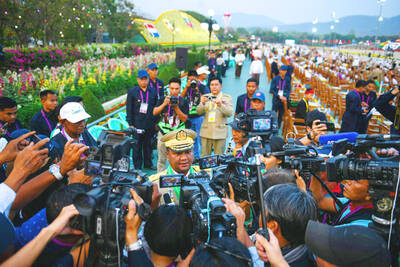There’s a lot to admire about Tom Hugo, and not just the washboard abs that are a glaring feature of his Twitter account profile photo.
For starters, Tom Hugo seems to be well-versed in Chinese, and he evidently cares deeply about Tibetans, judging from the profusion of messages he has posted on Twitter in recent months: There are photographs of Tibetans in “unique exotic dress,” articles showcasing the Tibetans’ deep appreciation for China’s governance of the region and video clips that portray happy Tibetans singing and dancing on state-run television.
“Tibetans hail bumper harvest of highland barley,” the headline on one recent posting read.
There’s only one problem with Tom Hugo’s Twitter account: It’s fake.
The visage accompanying the account belongs to a Brazilian model named Felipe Berto, and nearly every video, article and photograph the ersatz Tom Hugo tweets comes via propaganda Web sites linked to the Chinese government.
The ruse is not an isolated one. In recent days, Free Tibet, an advocacy group based in London, has identified nearly 100 similar sham accounts whose sole purpose appears to be disseminating upbeat news and treacly stories about Tibet and Xinjiang, the region in western China whose native Uighurs, like the Tibetans, have bridled under Beijing’s rule.
“When it comes to Tibet, nothing that China does surprises us, but this appears to be something new,” said Alistair Currie, the media manager for Free Tibet, who says the group’s researchers have stumbled upon thousands of other Twitter accounts they believe were also created to spread pro-China propaganda. “It’s an insidious effort to change the message and muddy the waters about Tibet.”
Although there is no direct evidence to link the Chinese government to the phony accounts, the content and breadth of the effort would suggest the involvement of a state actor. The subterfuge is not dissimilar to that carried out by members of China’s so-called Fifty Cent Party, the government-paid lurkers who earn 0.5 yuan (US$0.08) per posting on Internet message boards and chat rooms in an attempt to sway public opinion on issues deemed delicate by the Chinese Communist Party.
“I genuinely struggle to think of anyone else who would stand to gain from this,” Currie said of the fake Twitter accounts.
An employee of Wuzhou Media Corp, the Beijing company that creates the Web sites often featured in such tweets, said he knew nothing about the bogus accounts. However, in an interview, he suggested that such tactics fit in well with the company’s mission of producing propaganda tailored to Western audiences.
“We use a tone and style that’s easier for foreigners to accept,” said the employee, who would give only his surname, Yu.
The company, he said, has a staff of nearly 300 people.
The Chinese Ministry of Foreign Affairs and the Chinese State Council Information Office, the government agency that regulates the Internet in China, did not immediately respond to interview requests on Monday.
The use of fake Twitter accounts would also appear to dovetail with China’s increasingly sophisticated effort to present the country in a more flattering light while trying to bring the world around to its point of view on contentious issues, among them the continuing territorial dispute with Japan and widespread perception in the West that China restricts religious freedom and represses ethnic minorities like Tibetans and Uighurs.
In recent years, the government has opened many college campuses across the globe with Confucius Institutes and financed overseas newscasts of national broadcaster CCTV. In the most recent soft power push, state-owned film companies have teamed up with Hollywood to produce blockbusters, like Transformers: Age of Extinction, featuring Chinese actors.
However, when it comes to leveraging Western social media outlets like Twitter, Facebook and YouTube — all of which are blocked here — Beijing’s efforts would appear to be a bit ham-handed. On Twitter, many of the fake accounts identified by Free Tibet use stock images or headshots found on the sites of commercial photographers in the US.
Others employ the likenesses of actors, like Erica Durance, who played Lois Lane in the television series Smallville, or in one case, Syd Barrett, former lead vocalist of Pink Floyd, who died in 2006. Oddly, many of the Twitter handles, like Oliver Nina, Felix James and Philomena Rebecca, appear to be created through the combination of two first names. Nearly all the profile images are those of Caucasians.
Kirsten Kowalski, a photographer from suburban Atlanta, Georgia, was dismayed to learn that a portrait she had taken of a high-school student ended up as Lydia May, a woman who, judging from her tweets, was peeved by the Dalai Lama’s visit to the US this year, but also thrilled with an article titled “Xinjiang eyes housing, education for poverty mitigation.”
“It’s not like she’s being used to promote horrible stuff, but it’s still her likeness and she’s just a teenager,” Kowalski said by telephone. “It’s kind of bizarre, and frustrating. And it’s also illegal, at least in the United States.”
Fake accounts on Twitter are not new — some experts estimate that as many as 9 percent of all Twitter handles are made up, although the company says the figure is less than 5 percent, according to its securities filings. Jim Prosser, a spokesman for Twitter, said the company works hard to weed out illegitimate accounts and sometimes takes legal action against those who abuse its rules.
“We have a variety of automated and manual controls we constantly use to detect, flag and suspend accounts created solely for spam purposes,” he said in an e-mail.
It is hard to say whether the counterfeit Twitter accounts that disseminate pro-Chinese propaganda are having the desired impact. Tom Hugo has more than 2,600 followers, but many appear to be fellow fraudsters who retweet the same material. One recent tweet, an article that described the Dalai Lama as a “chess piece” used by the US to contain China, was retweeted 6,500 times.
Most of the accounts, however, are more like that of the putative Felix James, who has just a few dozen followers, and who seems to rarely get retweets of his bland postings about tourist attractions in Tibet (although perhaps it is because his profile photo, a man with a cellphone glued to his ear, is a stock advertising image that can be found on scores of Web sites, including those selling curtains, shipping containers and telecommunications software).

In the sweltering streets of Jakarta, buskers carry towering, hollow puppets and pass around a bucket for donations. Now, they fear becoming outlaws. City authorities said they would crack down on use of the sacred ondel-ondel puppets, which can stand as tall as a truck, and they are drafting legislation to remove what they view as a street nuisance. Performances featuring the puppets — originally used by Jakarta’s Betawi people to ward off evil spirits — would be allowed only at set events. The ban could leave many ondel-ondel buskers in Jakarta jobless. “I am confused and anxious. I fear getting raided or even

POLITICAL PATRIARCHS: Recent clashes between Thailand and Cambodia are driven by an escalating feud between rival political families, analysts say The dispute over Thailand and Cambodia’s contested border, which dates back more than a century to disagreements over colonial-era maps, has broken into conflict before. However, the most recent clashes, which erupted on Thursday, have been fueled by another factor: a bitter feud between two powerful political patriarchs. Cambodian Senate President and former prime minister Hun Sen, 72, and former Thai prime minister Thaksin Shinawatra, 76, were once such close friends that they reportedly called one another brothers. Hun Sen has, over the years, supported Thaksin’s family during their long-running power struggle with Thailand’s military. Thaksin and his sister Yingluck stayed

Kemal Ozdemir looked up at the bare peaks of Mount Cilo in Turkey’s Kurdish majority southeast. “There were glaciers 10 years ago,” he recalled under a cloudless sky. A mountain guide for 15 years, Ozdemir then turned toward the torrent carrying dozens of blocks of ice below a slope covered with grass and rocks — a sign of glacier loss being exacerbated by global warming. “You can see that there are quite a few pieces of glacier in the water right now ... the reason why the waterfalls flow lushly actually shows us how fast the ice is melting,” he said.

RESTRUCTURE: Myanmar’s military has ended emergency rule and announced plans for elections in December, but critics said the move aims to entrench junta control Myanmar’s military government announced on Thursday that it was ending the state of emergency declared after it seized power in 2021 and would restructure administrative bodies to prepare for the new election at the end of the year. However, the polls planned for an unspecified date in December face serious obstacles, including a civil war raging over most of the country and pledges by opponents of the military rule to derail the election because they believe it can be neither free nor fair. Under the restructuring, Myanmar’s junta chief Min Aung Hlaing is giving up two posts, but would stay at the